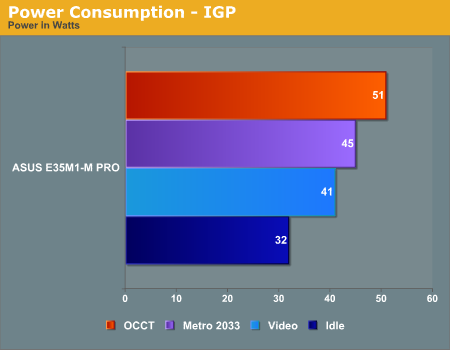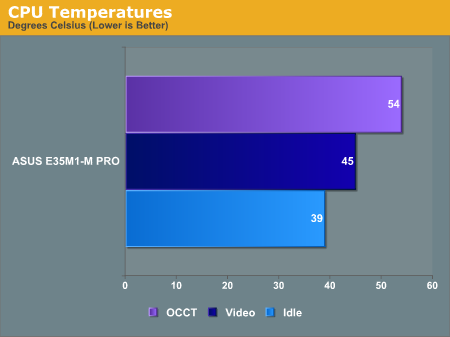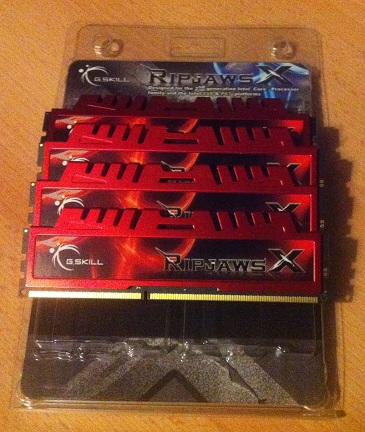ASUS E35M1-M Pro Review - Anyone For Fusion?
by Brendan van Varik on October 25, 2011 5:00 AM EST- Posted in
- Asus
- Motherboards
- Fusion
- E-350
Test Setup
| Processor |
AMD Fusion APU E-350 Dual-Core 1.6 GHz Up to 2 "Bobcat" cores, FT1 BGA 80 Stream Processors, 500 MHz |
| Motherboards | ASUS E35M1-M PRO |
| Cooling | Standard Cooling |
| Power Supply | Jeantech 250 W |
| Memory | G.Skill RipjawsX F3-14900CL9Q-16GBXL |
| Memory Settings | DDR3 1333MHz - 9-9-9-24 1T at 1.5 V |
| Hard Drive | OCZ Vertex 3 240GB |
| Optical Drive | Samsung SH-S223Q |
| Case | Dimastech Bench Table |
| Operating System | Windows 7 64-bit Ultimate |
| SATA Testing | OCZ Vertex 3 240GB |
| USB 2/3 Testing | Patriot 64GB SuperSonic USB 3.0 |
Many thanks to…
Before we go any further, I'd like to take the time to thank G.Skill for providing us with a set of their RipJawsX RAM for my future AMD reviews, in particular, the F3-14900CL9Q-16GBXL kit of which two sticks were used. It is a 16GB (4x4GB) kit which is rated at DDR3-1866MHz with 9-10-9-28 timings on as little as 1.5 volts. It is currently available from Newegg for $149.99.
Power Consumption
Power consumption was tested on the system as a whole with a wall meter connected to the power supply, while in an IGP configuration. This method allows us to compare the power management of the UEFI and the board to supply components with power under load, and includes typical PSU losses due to efficiency. These are the real world values that consumers may expect from a typical system (minus the monitor) using this motherboard. The power supply used for this test was a generic 250W model from JeanTech.

Out of the A50M motherboards which we have had on test, the ASUS E35M1-M PRO has the lowest average power rating across the four tests which we ran.
CPU Temperatures
With most users running boards on purely default BIOS settings, we are running at default settings for the CPU temperature tests. The results of a CPU Temperature test are not easily interpretable – if a motherboard vendor has buffered the amount of copper in the board between the power delivery and the CPU, this lowers the resistance and increases the CPU default voltage causing higher temperatures (but better stability). However, a high temperature could result from using different types of onboard devices, FETs, or the quality of the CPU temperature sensor, so the overall interpretation is purely speculative. The only thing a CPU test can say for sure is how warm the CPU is.
It could be argued that the CPU temperature is an indication of how well (or how adventurous) the vendor has their BIOS configured on automatic settings. A certain number of vendors not making CPU voltage, turbo voltage or LLC options configurable to the end user, which would directly affect power consumption and CPU temperatures at various usage levels.

The thermal tests were conducted without the included fan, just like the other Fusion motherboards. As you would expect, the temperatures are significantly lower if you use the fan. For example, if you stress the system with OCCT, the temperatures come down from 54 °C to just 39 °C. The fan is whisper quiet during normal operation and should not be noticed in a HTPC environment - however, when the system is stressed and the fan speeds up to 100%, it does get quite loud.











66 Comments
View All Comments
mino - Wednesday, October 26, 2011 - link
IF not in a hurry, you better wait for a dual-core E2-series Llano.UrQuan3 - Wednesday, November 9, 2011 - link
I wish I had tested Netflix. 1080p youtube and 720p crunchyroll play fine, but flash has hardware acceleration on the E-350.Since I've gotten several 'free' Nexflix offers, maybe I should test it.
jacob733 - Tuesday, October 25, 2011 - link
What about the other SATA channels? It's nice to see throughput with a single SSD on a single channel, but all sorts of other effects come into play if you load all channels at once. For example my H55 board can be saturated even by LP class magnetic HDDs if I load all 6 channels due to channel sharing of some kind. Would be nice to know as apart from HTPC then E35M1-M Pro also looks perfect for homebrew NAS.firsthour - Tuesday, October 25, 2011 - link
Anyone have any experience running a FreeNAS box off this? I like the idea of the low power along with 5+1 SATA. Max 8GB memory is my only concern that I can think of, considering how hungry ZFS is.Anything else I should be concerned about? Is it worth waiting for an E-450 release?
mino - Wednesday, October 26, 2011 - link
AM3+ along with X2 240e is a far better choice for FreeNAS or simmilar- ECC
- excellent FullATX mobos with a bunch of slots for RAID/NIC's
fubird - Tuesday, October 25, 2011 - link
can I use i3-2100T and thermalright HR-02 to build a fanless system? Since I need 2 HDMI port and and the trend is lossless music file is becoming larger and larger, I don't think APU can handle that for a long run. That's why I prefer SB, but 0dB noise is a must.frozentundra123456 - Tuesday, October 25, 2011 - link
Why not test some older or less demanding games instead of Metro 2033 and Dirt?Both these games are clearly unplayable on this platform, so does a frame per second or two really make any difference?
Maybe try Sims 3, or Half Life 2, or KOTOR or Mass Effect, WoW or something. I cant think of any more specific games that might be actually playable, but I am sure there are a lot of games from the 2005 or so era that might still be fun and actually playable on this system.
Fradelius - Tuesday, October 25, 2011 - link
totally agree, testing crysis on this is not a wise ideawow on the other side.. works!
silverblue - Wednesday, October 26, 2011 - link
http://www.anandtech.com/show/4218/amds-brazo-e350...E-450 would mean a small improvement though not necessarily anything really measurable.
TSnor - Tuesday, October 25, 2011 - link
Article says "The operating system is installed on the OCZ Vertex 3 240GB SSD, which is rated at up to 550 MB/s read and up to 520 MB/s write, and the sequential test is run at the 5 x 1000 MB level on a separate clean partition. "BUT this doesn't work on a sandforce based SSD. The SSD does not respect partition boundaries, it pools all the flash memory to maximize performance and minimize wear. Write speed especially is a function of the size of the data PREVIOUSLY written to the part of the SSD that will be reused. Depending on whether or not the drive was previously written with large block writes (128K, 256K) or small (8K or less) block writes a sandforce controller can see a 2X write speed difference.
Net, I would not give much value to the comparative results of the SSD testing. The differences are probably not SATA port related.